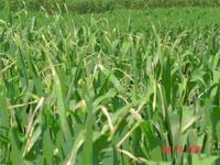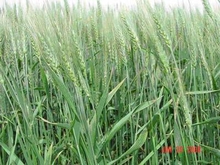Under certain conditions, necrotic areas on wheat flag leaves can look like a severe disease outbreak: The flag leaf dies back, starting at the tip and moving toward the base of the leaf . (Photos 1 and 2).
This isn’t a disease, but symptoms caused by any of the following:
- Hot, dry and windy weather (Photo 1).
- A physiological phenomenon called leaf tip necrosis (Photo 2).
- A combination of the two.
The actual impact of heat stress is probably less than you’d think, as the remaining canopy has a great ability to compensate for this type of physiological damage. In either case, there’s nothing producers can do to avoid or alleviate the symptoms.
Causes and symptoms
The weather injury happens when a tender, just-emerged flag leaf experiences hot, dry and windy weather. Drought stress will exacerbate symptoms. The flag leaf’s whole tip tends to be necrotic and will often fold over.
Leaf tip necrosis progresses from the margins of the flag leaf tip and lower leaves should show some signs of it as well. Also, leaf tip necrosis should be visible on all flag leaves, whereas the dying back due to hot, dry weather may appear on only a portion of the leaves.
Leaf tip necrosis’ severity depends on both the variety and the growing conditions during flag leaf emergence and early grainfill. This is why some varieties tend to show a lot more leaf tip necrosis than others.
Leaf rust gene resistance and leaf tip necrosis
To some extent, leaf tip necrosis is observed in all wheat varieties containing the leaf rust gene resistance gene Lr34. Lr34 is a so-called “slow-rusting gene” that provides durable resistance to leaf rust.
Wheat cultivars that carry the gene display a longer latency period for infection and fewer, smaller rust pustules. It was first described in the cultivar Frontana in 1966. Chris was the first University of Minnesota release that carried the resistance gene, and it’s present in many of our current hard red spring wheat (HRSW) varieties.
The presence of Lr34 carries a slight yield penalty in exchange for the absence of leaf rust. However, the overall benefit of Lr34 outweighs both the cosmetic and yield penalties.
Distinguishing symptoms from barley yellow dwarf virus
Some may mistake the symptoms of hot, dry and windy weather and leaf tip necrosis as symptoms of barley yellow dwarf virus (BYDV).
Both physiological injuries distinguish themselves from BYDV because they lack the corn yellow color of the flag leaf. Instead, flag leaf burning and leaf tip necrosis show a true necrosis, with the leaf tissue dying off.
Reviewed in 2021



